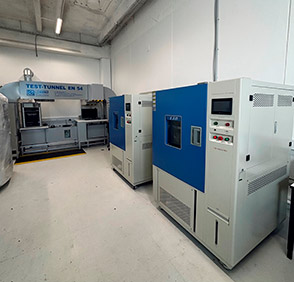Published: 06.10.25
Europe lacks facilities for testing fire detection systems. DBI is now changing that with a new state-of-the-art laboratory and a new accredited testing area.
For manufacturers of fire detection systems, getting new products onto the market can be difficult. Up until now, they had to arm themselves with patience because of capacity shortages and long waiting times for testing – and after the tests, they had to find a certification body that could certify the tested products so they could obtain the necessary CE marking.
That all becomes much easier now that DBI has established the Nordic region’s first laboratory for accredited testing of detection systems in accordance with the EN54 series. The new laboratory is called the Fire Detection Test Lab, and will also contribute to the GTS goal of strengthening companies’ competitiveness through knowledge, technology, and testing facilities.
“We can test a range of products such as optical smoke detectors, heat detectors, fire panels, power supply equipment for fire panels, and manual call points. In other words, we can test entire systems, which is exactly what companies require,” says Mathias Revall Delcomyn, Manager of the new test laboratory, and elaborates:
“Our new test equipment includes a state-of-the-art smoke tunnel, chambers for both heat and cold testing, a shock and vibration unit, a gas cabinet, and a Fire Test Room where detectors are exposed to real fire and smoke. With this setup, we can test across a wide range of conditions, including smoke, temperature, humidity, vibrations, wind speed, and corrosion,” he says.
DBI’s subsidiary, DBI Certification A/S, has certified products in accordance with the EN54 series for many years, but customers have lacked a single place where they could both have their products tested and certified.
“Although DBI and DBI Certification are two separate companies, it makes a big difference for manufacturers that we work under the same roof. The process becomes faster and more efficient, which will shorten time-to-market for both Danish and international detection products. With the establishment of the new laboratory, we can also reduce waiting times for testing and help customers reach their goals more quickly,” says Mathias Revall Delcomyn, adding:
“DBI has had an accredited fire laboratory and carried out accredited fire tests for many years. So we know exactly what we’re doing. In addition, we have strong focus on close partnerships with our customers. This ensures transparency and good dialogue throughout the entire process – from testing to certification.”
DBI can already now carry out tests for research and development purposes in the new laboratory. And in November, the lab is expected to achieve ISO 17025 accreditation for a range of EN54 standards (see below).
“Our first accreditation covers products for the construction sector, which is the most widespread application area for detection systems, since all countries require detection in both businesses and public buildings,” says Mathias Revall Delcomyn, continuing:
“Once that accreditation is in place, our team will move on to the next phase, which includes accreditation for relevant marine standards. The marine area is more specialized, with additional requirements from directives, regulations, and individual insurance companies. We expect to have that accreditation in place by 2026.”
“But already now it is possible to book both R&D tests and accredited tests in our new facilities. And the first orders are already starting to come in. We are very much looking forward to helping both Danish and international companies with holistic solutions that make it easy and safe to test and certify detection systems,” says Mathias Revall Delcomyn.
|
EN54-2 |
Control and Indicating Equipment |
|
EN54-4 |
Power Supply Equipment |
|
EN54-5 |
Heat Detectors – Point Heat Detectors |
|
EN54-7 |
Smoke Detectors - Point Detectors using scattered light, transmitted light or ionization |
|
EN54-11 |
Manual Call Points |
|
EN54-17 |
Short Circuit Isolators |
|
EN54-18 |
Input/Output Devices |
